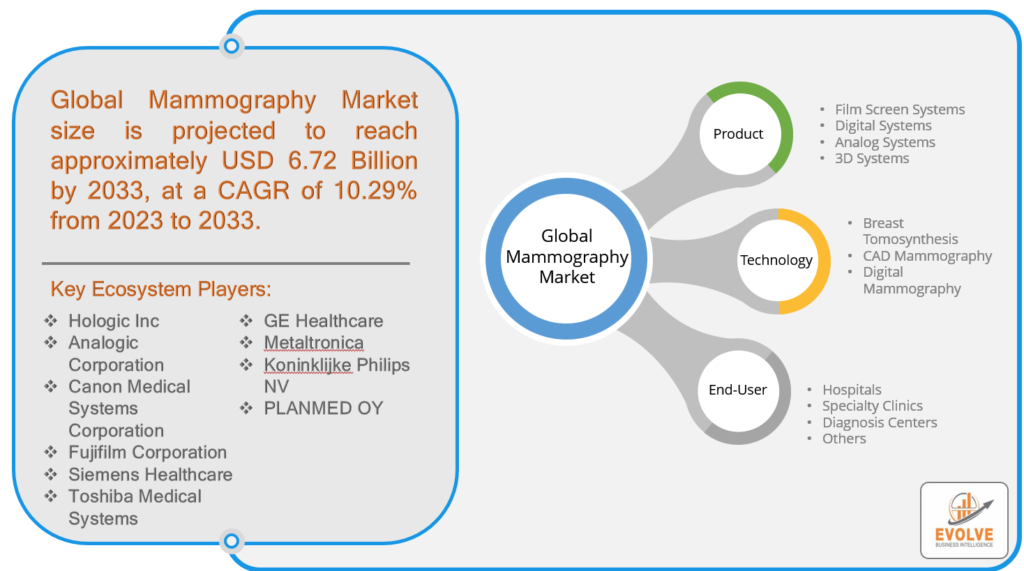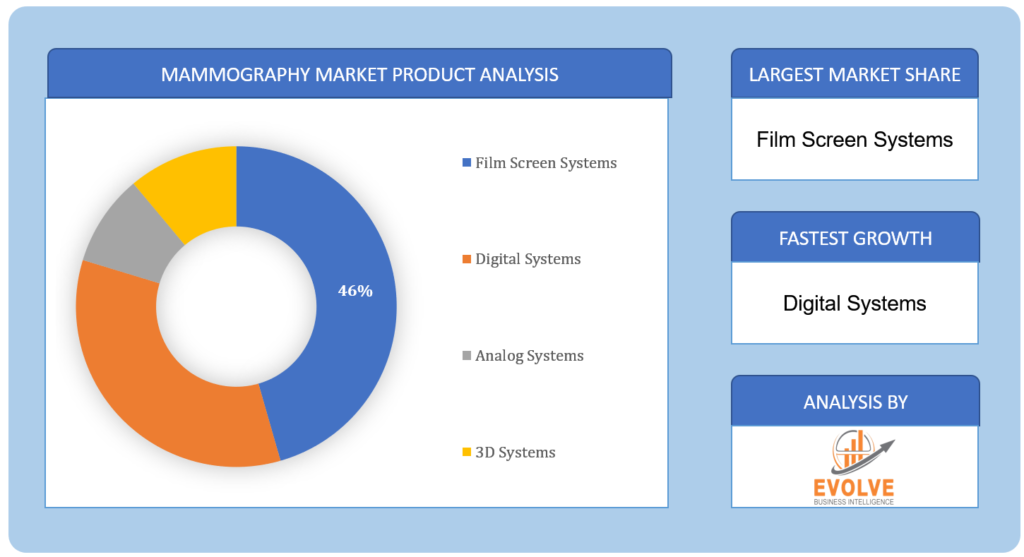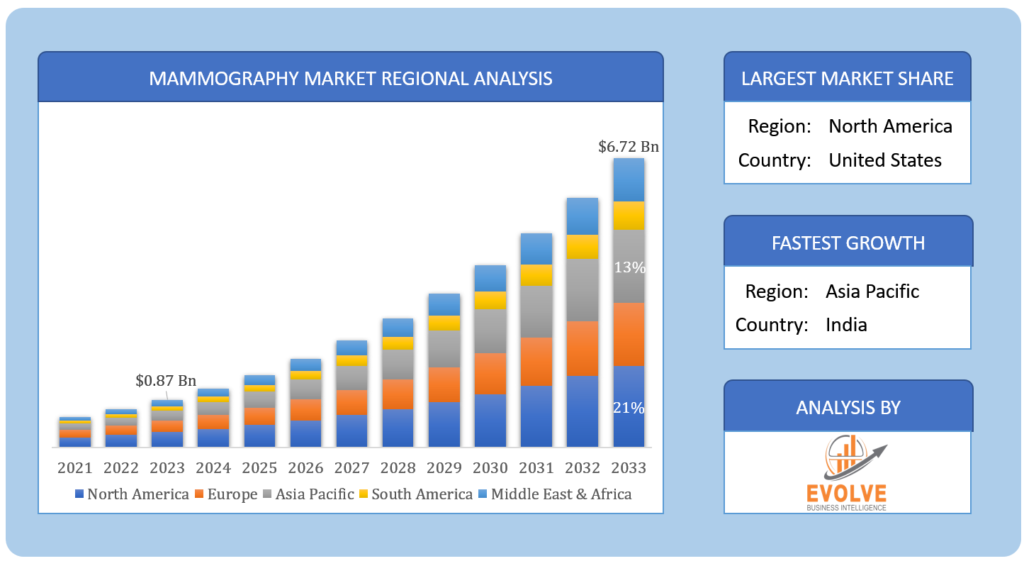The global Mammography market size is projected to reach approximately USD 6.72 Billion by 2033, at a CAGR of 10.29% from 2023 to 2033. Mammography is a medical imaging technique used to detect breast abnormalities, such as tumors or cysts, in their early stages. It involves taking X-ray images of breast tissue using a specialized machine called a mammogram. Mammography is primarily used for breast cancer screening, as it can detect small tumors that may not be palpable during a physical examination. It is also used for diagnostic purposes to further evaluate breast abnormalities found during clinical examinations or other imaging studies. Mammography is a critical tool in the early detection of breast cancer, which can improve the chances of successful treatment and survival.
The COVID-19 pandemic had a negative impact on the mammography market. The pandemic has disrupted routine healthcare services, including mammography screenings, due to various factors such as lockdowns, social distancing measures, prioritization of COVID-19 patients, and concerns about infection transmission in healthcare facilities. As a result, many mammography screening programs and facilities have experienced reduced patient volumes and delayed or canceled appointments.
Mammography Market Dynamics
The major factors that have impacted the growth of Mammography are as follows:
Drivers:
Increasing awareness about breast cancer
Rising awareness about breast cancer and the importance of early detection has been a significant driving factor for the mammography market. Breast cancer is a leading cause of cancer-related deaths among women worldwide, and mammography screening is recognized as an effective method for early detection and improved treatment outcomes.
Restraint:
- Limited access to healthcare facilities
Accessibility to mammography facilities can be a restraint factor, especially in rural or remote areas where access to healthcare facilities may be limited. Lack of proximity to mammography centers, transportation challenges, and geographical barriers can hinder patients’ ability to undergo regular mammography screenings, leading to reduced utilization and early detection.
Opportunity:
Personalized medicine and precision imaging
The development of personalized medicine and precision imaging approaches for breast cancer, such as molecular profiling, genomic testing, and targeted therapies, presents opportunities for the integration of mammography with other advanced diagnostic techniques. This can potentially lead to improved patient outcomes and more effective breast cancer management strategies.
Mammography Market Segment Overview
Based on the Product, the Mammography market is segmented based on Film Screen Systems, Digital Systems, Analog Systems, and 3D Systems. During the projection period, the Digital Systems segment is expected to hold the largest market share. Digital mammography is a type of mammography that uses digital detectors to capture and convert X-ray images of the breast into digital images that can be viewed and analyzed on a computer. Digital mammography offers several advantages over traditional film-based mammography, including higher image resolution, improved image quality, reduced radiation dose, and digital storage and retrieval capabilities.
By Technology
Based on Technology, the global Mammography market has been divided into Breast Tomosynthesis, CAD Mammography, and Digital Mammography. The Breast Tomosynthesis segment is expected to hold the largest market share. The segment’s larger market share can be attributed to the growing awareness about the benefits of breast tomosynthesis, advancements in tomosynthesis technology, and increasing demand for more accurate and reliable breast cancer screening methods.
By End-User
Based on End-User, the global Mammography market has been divided into Hospitals, Specialty Clinics, Diagnosis Centers, and Others. The Hospitals segment is expected to hold the largest market share. Hospitals may have well-equipped facilities, skilled personnel, and established quality assurance programs, which can contribute to the accurate and reliable delivery of mammography services.
Global Mammography Market Share, by Segmentation
 Mammography Market Regional Analysis
Mammography Market Regional Analysis
Based on region, the global Mammography market has been divided into North America, Europe, Asia-Pacific, and the Rest of the World. North America is projected to dominate the use of the Mammography market followed by the Asia-Pacific and Europe regions.
North America Market
North America has historically been one of the major regions in the mammography market and has held a significant market share. The region is known for its advanced healthcare infrastructure, well-established breast cancer screening programs, and increasing awareness about the importance of early breast cancer detection. Several factors contribute to North America’s significant market share in the mammography market. These include a high prevalence of breast cancer, favorable reimbursement policies for mammography services, well-developed healthcare facilities, and advanced imaging technologies. Additionally, increased awareness about breast cancer screening and advocacy efforts to promote regular mammography screenings have contributed to the growth of the mammography market in North America.
Asia-Pacific Market
Asia-Pacific is expected to be a significant growth market for mammography. The region has a large and growing population, increasing healthcare awareness, improving healthcare infrastructure, and rising incidences of breast cancer. These factors are driving the demand for mammography services in the Asia-Pacific region. Several key factors contribute to the expected growth of the mammography market in Asia-Pacific. These include increasing awareness about breast cancer and the importance of early detection, improving healthcare infrastructure, rising disposable incomes, and changing lifestyle patterns leading to an increased risk of breast cancer. Moreover, the governments in many Asia-Pacific countries are focusing on developing breast cancer screening programs and policies to promote early detection and reduce breast cancer-related morbidity and mortality.
Competitive Landscape
The market comprises tier-1, tier-2, and local players. With their wide product portfolios, tier-1 and tier-2 players have a global reach. Since of their strategic innovations and broad regional presence, companies such as Analogic Corporation, Canon Medical Systems Corporation, Fujifilm Corporation, and Siemens Healthcare lead the global Mammography business. To increase their market position and attract a wide consumer base, the businesses are employing various strategies, such as growth, product releases, and alliances.
Prominent Players:
- Hologic Inc
- Analogic Corporation
- Canon Medical Systems Corporation
- Fujifilm Corporation
- Siemens Healthcare
- Toshiba Medical Systems
- GE Healthcare
- Metaltronica
- Koninklijke Philips NV
- PLANMED OY
Scope of the Report
Global Mammography Market, by Product
- Film Screen Systems
- Digital Systems
- Analog Systems
- 3D Systems
Global Mammography Market, by Technology
- Breast Tomosynthesis
- CAD Mammography
- Digital Mammography
Global Mammography Market, by End-User
- Hospitals
- Specialty Clinics
- Diagnosis Centers
- Others
Global Mammography Market, by Region
- North America
- US
- Canada
- Mexico
- Europe
- UK
- Germany
- France
- Italy
- Rest of Europe
- Asia Pacific
- China
- Japan
- South Korea
- India
- Rest of Asia Pacific
- Rest of the World
| Parameters | Indicators |
|---|---|
| Market Size | 2033: $ 6.72 Billion |
| CAGR | 10.29% CAGR (2023-2033) |
| Base year | 2022 |
| Forecast Period | 2023-2033 |
| Historical Data | 2021 |
| Report Coverage | Revenue Forecast, Competitive Landscape, Growth Factors, and Trends |
| Key Segmentations | Product, Technology, End-User |
| Geographies Covered | North America, Europe, Asia-Pacific, Latin America, Middle East, Africa |
| Key Vendors | Hologic Inc, Analogic Corporation, Canon Medical Systems Corporation, Fujifilm Corporation, Siemens Healthcare, Toshiba Medical Systems, GE Healthcare, Metaltronica, Koninklijke Philips NV, PLANMED OY |
| Key Market Opportunities | Personalized medicine and precision imaging |
| Key Market Drivers | Increasing awareness about breast cancer |
REPORT CONTENT BRIEF:
- High-level analysis of the current and future Mammography market trends and opportunities
- Detailed analysis of current market drivers, restraining factors, and opportunities in the future
- Mammography market historical market size for the year 2021, and forecast from 2023 to 2033
- Mammography market share analysis at each product level
- Competitor analysis with a detailed insight into its product segment, financial strength, and strategies adopted.
- Identifies key strategies adopted including product launches and developments, mergers and acquisitions, joint ventures, collaborations, and partnerships as well as funding taken and investment done, among others.
- To identify and understand the various factors involved in the global Mammography market affected by the pandemic
- To provide a detailed insight into the major companies operating in the market. The profiling will include the financial health of the company’s past 2-3 years with segmental and regional revenue breakup, product offering, recent developments, SWOT analysis, and key strategies.








